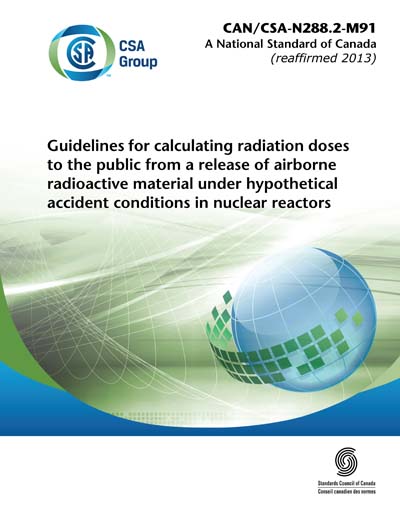Historical
CAN/CSA N288.2-M1991 (R2013)
CAN/CSA-N288.2-M91 (R2008) - Guidelines for Calculating Radiation Doses to the Public From a Release of Airborne Radioactive Material Under Hypothetical Accident Conditions in Nuclear Reactors
1. Scope
1.1 General1.1.1 This Standard provides guidelines and a methodology for calculating effective doses and thyroid doses to people (either individually or collectively) in the path of airborne radioactive material released from a nuclear facility following a hypothetical accident.
1.1.2 The specific radionuclides considered in this Standard are those associated with substances having the greatest potential for becoming airborne in reactor accidents [eg, tritium (HTO), noble gases and their daughters (Kr-Rb, Xe-Cs), and radioiodines (I)]; as well as certain radioactive particulates (eg, Cs, Ru, Sr, Te) that may become airborne under exceptional circumstances.
1.1.3 This Standard focuses on the calculation of radiation doses for (a) external exposures from radioactive material in the cloud; (b) internal exposures from inhalation of radioactive material in the cloud and also skin penetration of tritium; and (c) external exposures from radionuclides deposited on the ground, during and after passing of the cloud. Note: This Standard assumes that appropriate remedial actions are taken to prevent undue longer-term exposures associated with radionuclides deposited on the ground (eg, internal exposures due to consumption of contaminated foodstuffs).
1.1.4 This Standard uses a modified Gaussian plume model to evaluate the time-integrated concentration at downwind distances from 100 m to 100 km. The same atmospheric dispersion model may be found useful for evaluating concentrations of certain types of nonradioactive material released following accidents.
1.2 Application to Other Nuclear Facilities The guidelines and methodology may be applied to accidental releases from nuclear facilities other than nuclear power plants. However, depending on the radionuclides involved, reference to other publications may be required for the appropriate dosimetric data.
1.3 Limitations
1.3.1 This Standard does not cover the calculation of (a) doses to body organs other than the thyroid; or (b) doses for internal exposures from ingestion of contaminated foodstuffs (and water) and inhalation of radionuclides resuspended fro m the ground after the cloud has passed. However, data are available in the referenced publications for performing these calculations if desired.
1.3.2 This Standard should be used with caution for calculating doses in real accidents because the models assume that the meteorological conditions do not vary with time and space and that the topography of the terrain is homogeneous.
1.3.3 The values of the parameters in the models and equations have an inherent level of uncertainty. They are most reliable for dispersion over distances up to a few tens of kilometres. The accuracy of the recommended models and equations for dispersion and dose calculations is discussed and the uncertainty with which results may be predicted beyond a few tens of kilometres is emphasized (see Appendix A).
Content Provider
CSA America, Inc. [csa]






